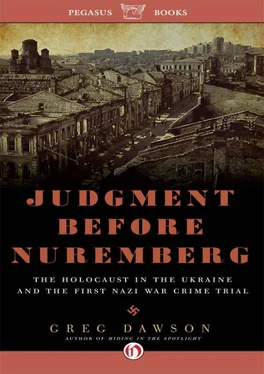At the time of the Nazi invasion in 1941, some 2.7 million Jews lived in the area that is now Ukraine. By 1945, about 60 percent—1.6 million—had perished. Roughly 900,000 Jews fled east to the Ural Mountains and Siberia ahead of the Germans, heeding rumors of Nazi atrocities at Babi Yar and points in western Ukraine where residents had little or no warning of the Nazi onslaught, and where in places there was near total extermination of Jews. Lviv had a pre-war Jewish population of 260,000 and lost an estimated 215,000, nearly 83 percent. In Ternopil, slightly to the east, an estimated 132,000 Jews were murdered—a staggering 97 percent of the population. Elsewhere, 100,000 survived the occupation in hiding or in Nazi camps and ghettos. Though Jewish life in Ukraine survived, shtetls did not. Thousands of the Jewish villages and agricultural settlements, a unique phenomenon for generations in eastern Europe, were swept away forever in the Nazi storm. They survive only in memory and in productions like the musical Fiddler on the Roof , set in a fictional Russian shtetl.
Because it is faceless, the physical destruction wreaked by German forces is perhaps even more difficult to fathom than the human loss. At the Nuremberg trials, chief Soviet prosecutor Roman Rudenko presented a statistical summary of the destruction in all Soviet territories, and it is difficult to conjure images which do justice to his words and numbers. As I write this in March 2011, the TV screen is filled with images of total devastation from the earthquake and tsunami in Japan. Imagine across Russia the wreckage of a thousand tsunamis.
“The German fascist invaders completely or partially destroyed or burned 1,710 cities and more than 70,000 villages and hamlets,” Rudenko told the Nuremburg court. “They burned or destroyed over six million buildings and rendered some twenty-five million persons homeless.
“The Germano-fascist invaders destroyed 31,850 industrial establishments employing some four million workers; they destroyed or removed from the country 239,000 electric motors and 175,000 metal cutting machines. The Germans destroyed 65,000 kilometers of railway tracks; 4,100 railway stations, 36,000 post and telegraph offices, telephone exchanges, and other installations for communications.
“The Germans destroyed or devastated 40,000 hospitals and other medical institutions, 84,000 schools, technical colleges, universities, institutes for scientific research, and 43,000 public libraries. The Hitlerites destroyed and looted 98,000 collective farms, 1,876 state farms, and 2,890 machine and tractor stations. They slaughtered, seized, or drove into Germany 7 million horses, 17 million head of horned cattle, 20 million pigs, 27 million sheep and goats, and 110 million head of poultry.”
In addition to everything in Rudenko’s litany, there was the flooding of mines and the poisoning of wells by the Nazis. The special commission of dignitaries and citizens, which gathered the evidence, estimated total damage to the Soviet economy, including loss of workers shipped to slave labor camps in Germany, to be 679 billion rubles. As Arad notes, at the time the ruble was worth more than the dollar.
Sherman’s conduct of war seems genteel by comparison. Here are excerpts from his Special Field Orders, No. 120, issued before his notorious March to the Sea, from Atlanta to Savannah.
“Soldiers must not enter the dwellings of inhabitants, or commit any trespass, but during a halt or a camp they may be permitted to gather turnips, potatoes, and other vegetables, and to drive stock to their camp. To army commanders alone is entrusted the power to destroy mills, houses, cotton gins, etc., for them this general principle is laid down: In districts and neighborhoods where the army is unmolested, no destruction of such property should be permitted. In all foraging, of whatever kind, the parties engaged will refrain from abusive or threatening language, and may, where the officer in command thinks proper, give written certificates of the facts, but no receipts, and they will endeavor to leave with each family a reasonable portion for their maintenance.”
Reading this, I thought of the night German soldiers stormed into my mother’s home in Kharkov in 1941, screaming “dirty Jews!”, slamming her mother Sara against the wall and holding a gun to her head, demanding gold from her father, which he did not have. The enraged looters tried to take the family’s Bechstein piano but could not maneuver it out the door. They settled for Dmitri Arshansky’s beloved violin. The Germans did not provide a “certificate of fact” for taking what my mother called “the fifth member of our family.”
To be sure, the Union army would never be mistaken for the Peace Corps. Soldiers often ignored Sherman’s stated restrictions on foraging, wrote historian Anne Bailey for The New Georgia Encyclopedia . “His men had destroyed all sources of food… and left behind a hungry and demoralized people. Although he did not level any towns, he did destroy buildings in places where there was resistance.” Bailey notes that “physical attacks on white civilians were few.”
In sum, this was war waged by a man who at least had a moral compass and occasionally checked it. In contrast, Himmler, chief implementer and rationalizer of Hitler’s genocidal vision in the East, displayed an aggressive contempt for anything resembling conventional morality or rules of war. In his topsy-turvy universe, the greatest virtue was being “hard” enough to embrace evil when others blinked. Many Germans speak favorably of eliminating the Jews, he said, but they do not have the strength to act on their beliefs.
“Of all those who talk this way, not one has seen it happen, not one has been through it,” Himmler told an assembly of Gruppenfuhrers (SS leaders) in 1943. “Most of you know what it means when a hundred corpses lie side by side, when five hundred lie there or when a thousand lie there. To have gone through this and to have remained decent—that has made us hard. This is a glorious page in our history.”
The record is thick with stories of men who seemed eager to share that glory and earn Himmler’s badge of honor by remaining “hard” and not succumbing to “weakness.” Consider the testimony of a captured German soldier, a private first class, in The Black Book , considered the Torah of Nazi atrocities in the Soviet Union. The machinegunning of three hundred men, women, and children into open graves is the least horrific part of his story of the carnage in one village.
“Little children were picked up by their feet and their heads smashed against a rock. One young girl had hidden in a barn behind a beam. When the SS men found her, one of them climbed up into the loft while the others formed a circle below with fixed bayonets. The girl was stabbed with a bayonet until she had no choice but to jump down. She was then literally run through with bayonets. When I asked the SS man in charge why such horrible things were being done, he said, ‘We kicked the Jews out of Germany, and now we have to do away with them here too.’ In the end all the livestock from the village was herded together and driven off, and the village was burned to the last house.” [2] Ilya Ehrenburg and Vasily Grossman, eds., The Black Book (Yad Vashem, 1980).
One fundamental way in which Sherman’s mission differed from Hitler’s is that he was making war to free slaves—Hitler wanted to make millions of new slaves. Himmler urged his Gruppenfuhrers to remember that it was their sacred, patriotic duty as Germans to subjugate these mongrel populations.
“Whether other races live well or die of hunger is only of interest to me insofar as we need them as slaves for our culture. Whether ten thousand Russian women collapse from exhaustion in building a tank ditch is of interest to me only insofar as the tank ditches are finished for Germany. We Germans, the only ones in the world with a decent attitude toward animals, will also adopt a decent attitude with regards to these human animals, but it is a sin against our own blood to worry about them and give them ideals.
Читать дальше












